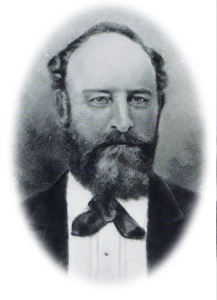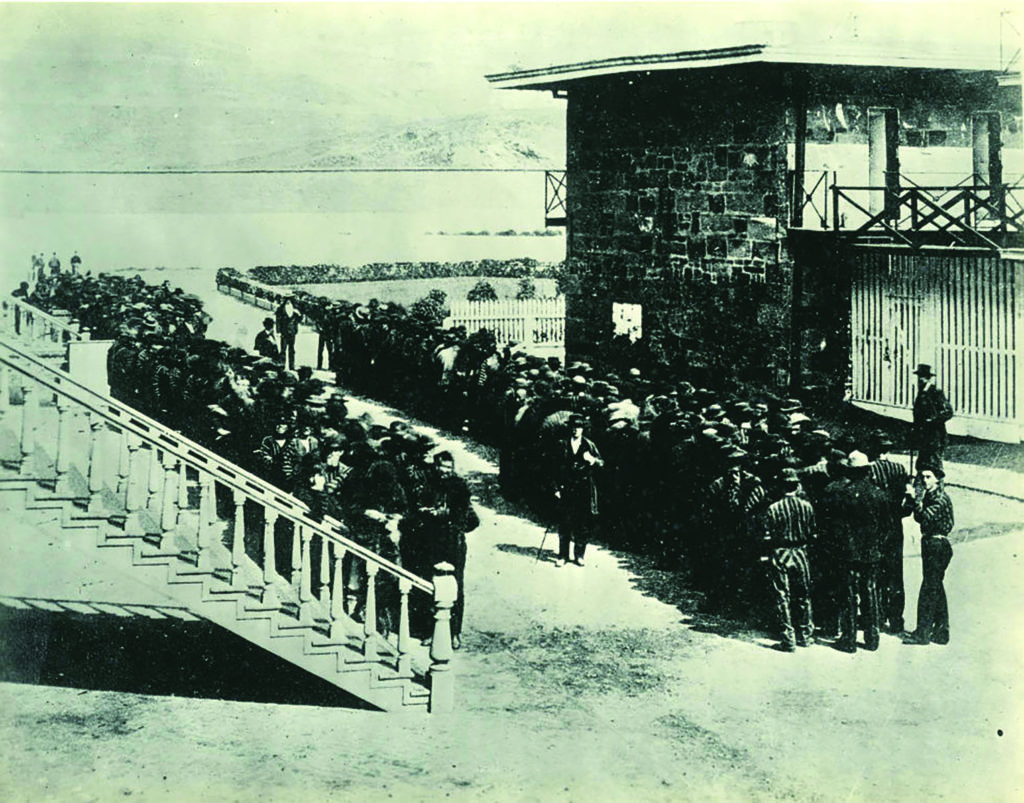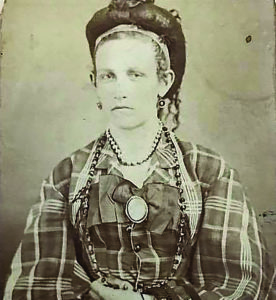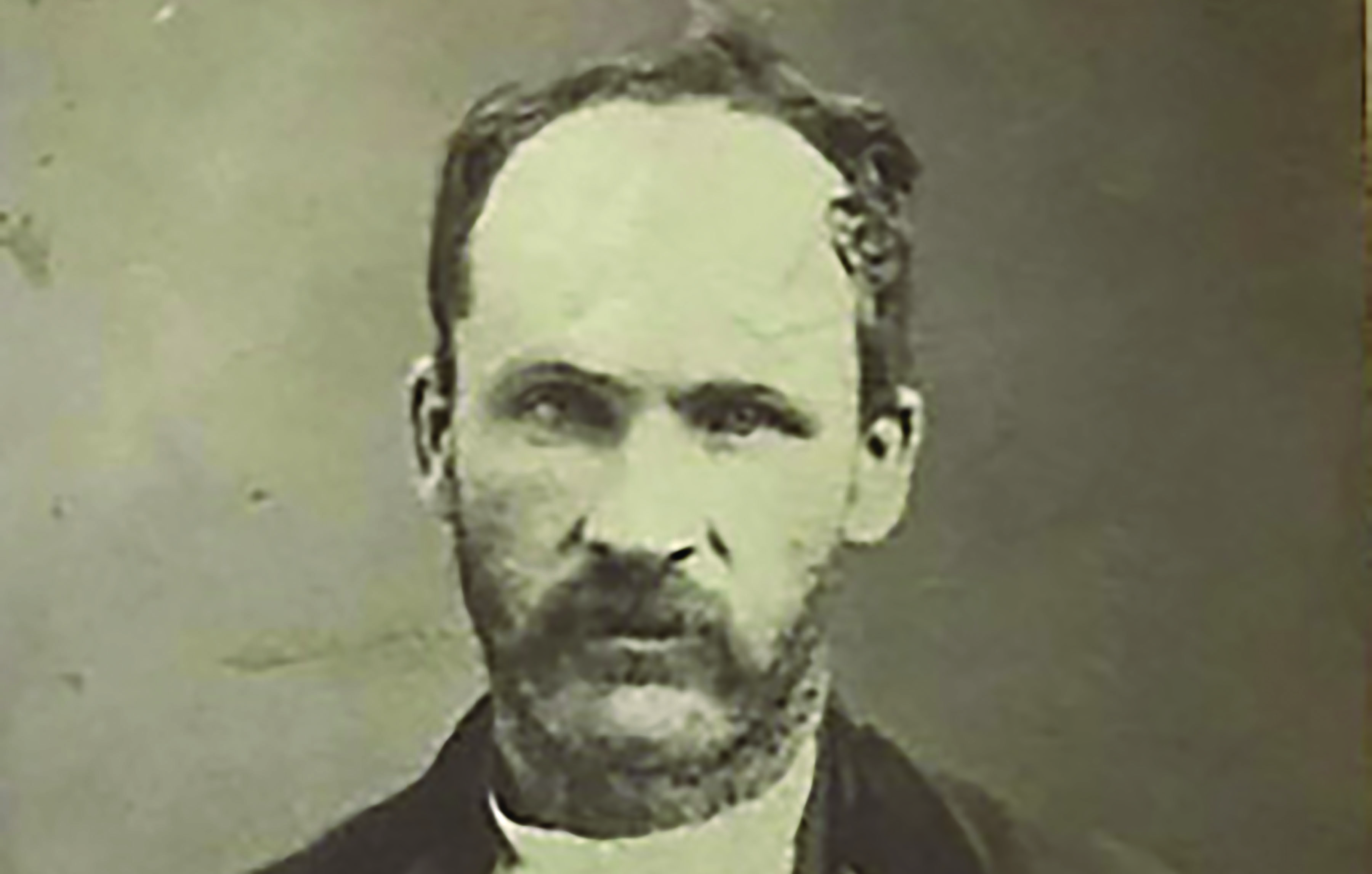Just past 1 a.m. on April 16, 1873, by the light of the moon, a man who had registered at the City Hotel as J.W. Williams approached the Sacramento County Jail. He wore no hat, no shoes, a coat turned inside out and a white handkerchief over the lower half of his face. Using a ladder, he climbed the south wall. From there he crept onto a utility shed over the adjoining courthouse boiler, scurried across to the kitchen roof and jumped down into the prison grounds. This was nimble work—especially for a Civil War veteran who’d been shot in the right ankle during the 1863 Siege of Port Hudson.
Heading toward the jailhouse door, the masked intruder drew a revolver. As he tugged a cord beside the jailhouse door, a clanging alarm bell shattered the stillness.
Inside the jail, Deputy Sheriff Manuel L. Cross drew his big six-shooter. For the last several nights he’d been expecting trouble, and he was ready for it—or as ready as he could be. A former assayer from Truckee, the 30-year-old deputy wasn’t accustomed to midnight gunfights. Sheriff Mike Bryte thought him more than capable. Cross was about to find out.

Banging open the jailhouse door with his gun at the ready, the deputy stepped onto the sill and paused, scanning the yard. Moving deliberately, he walked down the brick pathway leading south toward the outside gate to I Street. Five paces into the yard, Cross looked back toward the rear wall of the jail. There in the moonlight he spied the masked man, leveling a cocked revolver at the deputy’s head. Speaking in a low voice, the intruder said something indistinguishable through the white handkerchief. It was the last thing he’d ever say.
Cross wheeled and pulled the trigger. His first shot caught the intruder in the right breast. The deputy’s next shot crashed through the gunman’s handkerchief, smashing into his teeth. The impact of the bullets had thrown off the assailant’s aim, sending his two shots wide. Staggering, the mortally wounded man lurched toward the jailhouse door. Cross again squeezed the trigger, but his gun misfired. Moaning in pain, the masked man dropped his gun and ran inside. Leaving a trail of blood, he stumbled down the cellblock hall with Cross in pursuit. Careening headfirst into a brick wall, the intruder finally collapsed outside the cell holding a prisoner scheduled to hang the next day, the man he had come to rescue—his older brother, Charles J. Flinn.
From the man’s corpse authorities recovered papers identifying him as William J. Flinn. Reporters soon learned the deceased hailed from Lynn, Mass.—10 miles north of Boston—and was a former Union soldier, having enlisted in 1862 as a private in the 38th Massachusetts Volunteer Infantry. In the action at Port Hudson, he’d been commended for his bravery.
Whether it was bravery or foolishness, William Flinn had died trying to save brother Charles from a hangman’s rope. Had William known his brother as his victims had known him—a vicious criminal named “Mortimer”—one wonders if the young man would have instead come west to cheer on the executioner.
Arriving in California in 1858, Charles Flinn spent his mid-20s roaming between San Francisco, Sacramento and central Calaveras County, working stints as a miner, farmer, teamster, carpenter and tailor. It appears he ultimately decided there were easier ways to make money.
The first arrest that landed Flinn in prison came in 1862 in San Francisco. One night in April, around midnight, Detective Ben Bohen was standing in a doorway on Dupont Street, sheltering from a cold rain, when two men strolled by. The first was saloonkeeper Conrad Pfister, toting a satchel beneath his coat. Bohen didn’t recognize the man close on Pfister’s heels. The men had walked some 20 paces past the doorway when the detective heard Pfister cry out. Dashing from cover, Bohen saw the men grappling in the mud. After separating them, the detective determined the stranger had stalked and then attacked Pfister, seeking to rob the saloonkeeper of the $980 he carried in his satchel. Bohen arrested the assailant, who gave his name as Charles Mortimer. Promptly tried and convicted, he was sentenced to one year in San Quentin State Prison.

By fall of 1864, Mortimer was back in San Francisco. On the night of September 2, he was lounging at the Pony Express Saloon, at the corner of Commercial and Kearny Streets, and paying undue attention to Charles L. Wiggin, a mayoral clerk and prospective California state assemblyman. When Wiggin left to stroll the mile to his home on Geary Street, he failed to notice Mortimer shadowing him. After waiting outside some minutes, the stalker rang the doorbell. When a young lady answered, Mortimer told her he had important business with Mr. Wiggin and instructed her to show him his room. Once inside he chloroformed Wiggin and pocketed $1,500 worth of money and jewelry.
At the foot of the stairs, he met the young lady again. “How does Mr. Wiggin feel this morning?” she asked. “He has a severe headache and is going to try to sleep it off,” Mortimer dryly replied before escaping into the night.
Enter Detective George W. Rose, who was used to dealing with dangerous men. Known for his energy and efficiency, he had served on the San Francisco Police force for a decade, seven of those years as a detective. Adept at handling Chinatown toughs, Rose had been stabbed in “China Alley” and in another instance assaulted with a cleaver. But his encounter with Mortimer would prove the most violent.
Assigned the Wiggin case, Rose caught a break when he arrested ex-convict George Sibley for deserting USS Saranac. After jumping ship, Sibley had fallen in with Mortimer in Belmont, 23 miles south of San Francisco. On the strength of that tip, Rose confronted Mortimer there on September 9. The fugitive confessed to having buried the money and led the detective to a secluded rancho in Santa Clara County to recover it. “Rose kept his hand on his pistol, so I tried to light some matches and purposefully failed,” Mortimer recalled. “He, seeing this, tried his hand at it, which brought his hand from his pistol.” As the match blazed, Mortimer made his move. Grappling with the detective, he seized Rose’s knife and slashed at his throat, missing the carotid artery but carving into his windpipe. Mortimer then wrested away the detective’s pistol and used it to bludgeon him. When Rose shoved a hand in his assailant’s face, Mortimer responded by biting off the detective’s little finger. After cracking Rose over the head hard enough to audibly fracture his skull, Mortimer left him for dead.
But Rose wasn’t dead. Unarmed and unable to walk, the grievously wounded detective crawled nearly a mile to the nearest house. Doctors said he might never recover, but Rose beat the odds. Three months later he returned to service at the San Francisco Police Department.
Although Chief Martin J. Burke posted a generous $200 reward for “the apprehension of Charles James Mortimer,” the fugitive didn’t lie low. Heading north to Napa, he fell in with highwayman John “Black Jack” Bowen and a cohort known only as “Shanks.” Leaving Black Jack behind, the duo were soon joined by William Richardson, an escaped convict from the Oregon State Prison in Salem. For weeks the gang roamed the 240-mile stretch between Woodland and Yreka robbing stores, hotels and travelers. A posse of eight armed men finally captured the miscreants at Reeve’s Ferry on the Klamath River. After lashing the four to their horses, the posse brought them to Fort Jones. Richardson later managed to escape, but authorities transported the others to the Siskiyou County Jail in Yreka. Three months later Black Jack, Shanks and Mortimer (then using the alias “George Foster”) pleaded guilty to grand larceny. On Feb. 10, 1865, Judge Alexander M. Rosborough sentenced the men to three years each in San Quentin.
The following night the convicted robbers overpowered their jailer, who had opened the cell door to give one of them a drink of water. Leaving the man bound and gagged, the trio stole his keys and fled. Four days later authorities recaptured Mortimer, who in the process took a rifle round to the neck that barely missed his jugular vein. Judge Rosborough added four years to his sentence and asked Sheriff Andrew D. Crooks to transport the prisoner to San Quentin. The last stretch brought them by boat to the San Francisco waterfront.
Night had fallen by the time they docked, and although the state prison was just 10 miles north across the bay, Crooks decided to lock his charge in the city prison overnight and deliver him to San Quentin in the morning. Mortimer urgently tried to dissuade Crooks, insisting they could sleep comfortably enough on the boat. Suspicious of his intentions, Crooks refused the prisoner’s entreaties.
Almost immediately on entering the jail, officers recognized Mortimer. The jailer had scarcely turned the key in his cell door when Rose, who had gotten wind of Mortimer’s arrival, appeared. Enraged, the nine-fingered detective drew his pistol. Before Rose could shoot his nemesis, however, fellow officers overpowered him. “For some reason [Mortimer] was never prosecuted for his attack upon Officer Rose,” the San Francisco Chronicle noted. Thus, after serving out his seven-year sentence, Mortimer was released from San Quentin in 1872.
By then speculation was rampant Mortimer and Rose had been in cahoots from the start. The detective had certainly gone against protocol by having Mortimer lead him to the buried loot he had stolen from Wiggin instead of simply arresting the confessed thief. That Rose attempted to shoot Mortimer on spotting him in the city jail, yet still declined to press charges against him in what would have been a very public trial, also suggested the detective had something to hide.
On his release, Mortimer soon got into further mischief. Before the year was out, authorities again arrested the repeat offender—this time for murder.
On the morning of Sept. 20, 1872, Sacramento Police Officer George Wentworth was notified something was amiss at a popular saloon on Water Street. On arrival, he found the proprietress, Mary Gibson, lying dead in a pool of blood with her throat cut and bruises on her face. Clutched in her left hand was a clump of reddish-brown hair, which the officer deduced the victim had torn from her killer’s beard. Wentworth also found the bedroom had been ransacked. Missing was Gibson’s purse, some dresses and a ring. The saloon till had also been cleaned out.
It took police less than 24 hours to link Mortimer to the crime. Prior to the murder witnesses had seen him in Gibson’s saloon with live-in companion Carrie Spencer, the wayward daughter of a Mendocino farmer. Spencer told authorities that when Mortimer had returned to their shared hotel room the night of the murder, his face was scratched and about half of his chin whiskers were missing; he had visited a barber that morning and was sporting only a mustache. On searching the couple’s room, police discovered several dresses belonging to Gibson and placed the pair under arrest. When Spencer was being booked, Gibson’s ring tumbled out of her pocket. She quickly turned state’s evidence against her lover.

On March 13, 1873, Mortimer, charged with first-degree murder, appeared before Judge Thomas B. Reardon in Sacramento’s Sixth District Court. In addition to the material evidence, Spencer damningly testified the accused had confessed to having “croaked the old woman.” Three days later, after deliberating 35 minutes, the jury found Mortimer guilty. The judge sentenced him to hang.
A month later Mortimer watched helplessly from his cell as brother William—shot in the chest and mouth—collapsed outside his cell and died. Under such dire circumstances another man might have admitted defeat and accepted his fate, but Mortimer still had a couple tricks up his sleeve.
With nothing to lose, Mortimer first shared a sensational story with reporters about his connection with George Rose. According to Mortimer, the detective was a crook and a coward. Rose had intended not only to steal for himself Wiggin’s money and jewelry but also to pin a pawnshop robbery on Mortimer and collect the reward. Rose had specifically asked to handle the case in order to screen his involvement. The detective then arranged to meet his accomplice in Belmont. Suspecting Rose meant to kill him in order to keep his secret, Mortimer led him to the desolate site in Santa Clara and preemptively struck down the detective. Whether Mortimer was being truthful or slandering the career of a stalwart lawman was a moot point. Rose had since left the force and departed San Francisco for Salt Lake City. (Arrested in 1876 on a charge of complicity in the robbery of a Wells Fargo express car in Utah Territory, Rose may well have been the crooked cop Mortimer alleged.)
For his next act, Mortimer tried feigning insanity. He stopped speaking, gave no indication he understood spoken English and on one occasion lashed out at Cross as the deputy sheriff stood on the spot where brother William had died. Even when the youngest Mortimer brother, Frank M. Flinn, arrived from Massachusetts, Charles kept up the act. Hoping to force Sheriff Bryte’s hand, Mortimer’s attorney, Cameron H. King, wrote him a letter in which he cited Section 1221 of the California Penal Code: “If after judgment of death there is good reason to suppose that the defendant has become insane, the Sheriff of the county…may summon a jury of 12 persons to inquire into the supposed insanity.”
King then presented Bryte his best argument for such a diagnosis:
The circumstances attending his case are surely enough to drive an ordinary man insane. The severe shock which the death of his brother must have given him, the perfidy and treachery of the accomplices whom he had trusted, the remorse and pangs of conscience which he must have felt in contemplating his past life, his long incarceration in jail, would all conspire to overturn his mind and dethrone his reason.
Those who believed Mortimer insane generally thought his crimes were monstrous enough to deserve death. Most, however, figured he was merely putting on an antic disposition. As for Bryte, whether he bought Mortimer’s act or not was immaterial. The sheriff didn’t want the hanging delayed, and he certainly didn’t want a cold-blooded killer institutionalized. No second jury was ever summoned.
On May 15, the day of the hanging, Frank Flinn grumbled bitterly to a San Francisco Chronicle reporter that Bryte was having his brother Charles “officially murdered for the benefit of officers whom his living testimony would ruin.” Were the truth revealed about his brother’s accomplices on the police force, Frank alleged, “it would create an entire revolution in the criminal history of California.”
When deputies came to remove the condemned man from his cell around noon, Mortimer put up a violent struggle and continued his mad act. The Rev. David Deal spoke to him. “Charles, you have a mother that feels for you,” the pastor implored. “Speak and have your brother called here and talk to him. This is no time to feign insanity. Have you no message to send to your mother? You have but a very few moments before you are ushered into eternity.”
Affected by the reverend’s appeal, King spoke next to Mortimer. “Charley, do you know me?” the attorney asked. “We have done all we can for you. You must place your trust in God; there is no hope.” Mortimer gave no sign he understood either man. Among those attending the execution were Deputy Sheriff Cross, who had shot and killed Mortimer’s brother William, and the hulking Sheriff Bryte, who was reportedly all smiles.
After the hanging Frank, before returning to Massachusetts, had his brother’s body buried in the Sacramento City Cemetery. California lawmen and Mortimer’s surviving victims must have breathed a sigh of relief.
Matthew Bernstein teaches writing at Los Angeles City College and Matrix for Success Academy. For further reading, he recommends Celebrated Criminal Cases of America, by Thomas Samuel Duke, and The Maltese Falcon, by Dashiell Hammett.





